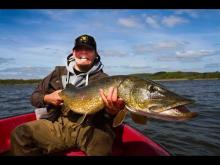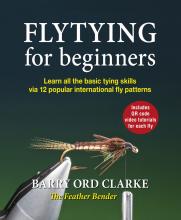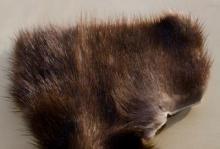A guide to fly-fishing for pike
Fly-fishing for pike is easily accessible and requires simple gear and few skills - and it's so rock and roll!
It's great to fly-fish for pike. Here is a short list of reasons why pike on the fly is so rock and roll.
- Pike Fishing requires neither long casts, classy or delicate presentation of the fly, and you can fish during the day, when the weather is good.
- It's a very rewarding fishing without high and expensive demands for equipment or technique, but in return offers outstanding fun and spectacular experiences.
- Pike fly Fishing is often very visual, you often see pikes following the fly and when a pike strikes it's often powerful and ferocious. When the fish is hooked, you are guaranteed an action packed fight. They want to swim, and occasionally jump, with gills open and teeth glinting in the sun.
- The Fishing is characterized by many fish with an average size far larger than most other types of flyfishing. A 6 pound fish is not large; 10 pounders are common and fish longer than three feet are not uncommon.
- Pike water is everywhere - almost. While very few of us have a trout stream in the backyard, a lot of us have excellent pike water nearby in the form of lakes, ponds, slow streams and canals.
Raw and brutal force
It's impossible not to be intrigued and seduced by this combination. Pike fly-fishing has all the aspects that make fishing the world's greatest hobby. Big strong fish that strike your fly with raw and brutal force and then put up a tough fight.
But although fishing is easily accessible and does not place the highest demands on gear and technique, there are some tips and tricks you want to know before you tie several bags of flash on large hooks and head for the water.
I love this fishing and I want to share my enthusiasm, my thoughts and experiences about pike fly-fishing with everyone. These are my best shortcuts to success with "The nail boxes" in your local pond.
The gear
It's big strong fish we're targeting; for these we use big bundles of materials that resembles giant scarecrows more than traditional flies. Fishing is often near the water lilies and weeds and it can be quite necessary to take a stand, play rough and push the gear to the the limit.
Also, if you have found a good pike water, it's nice to be able to protect fish stocks by shortening fights and release the fish fast and safely.
The rod
A 6, 7 or 8 weight works fine. Coastal gear or single hand salmon/seatrout gear will do the job. You do not have to go out and buy a full set of new gear.
For standard gear an 8 weight is your best choice. It has the power to cast the big flies with a minimum of effort, and can adequately control large and heavy fish. It's my experience that rods with a calm and slow action, can easily lift even very big flies off the water.
A rod with a calm, slow action decelerates the cast, making casting big flies more harmonic and comfortable. The slower action will make it easier for the fisherman to use less effort and just let the rod force the fly out. For my pike fishing I use the Sage pike rod. This is a 10 weight, but casts great with a Rio Pike WF 9. It has the power to cast the big flies with a minimum of effort and control large and heavy fish.
The reel
Pike fishing makes no specific demands on the reel as long as it's reliable and works. But as in all other fly fishing, I personally prefer reels with a large arbor.
The line
Use what you have; the key is to get to the water and fish. Use what you have at hand. Once you're hooked on fishing, you can then consider optimizing your gear. However, it's worth keeping in mind the following, when you have come that far: When you are throwing big flies it's far easier to do this using a line a bit heavier than normally. The heavy line pulls a big fly easier than a light line.
Personally, use the Rio Pike/Muskie WF line. This line is perfect. Short heavy head, very slick and durable coating, two colored to make it easier to release the cast at the right time.
I prefer a short heavy profile; this makes it easier controlling your cast. If your local lake is shallow, it's possible to make do with a floating line for all the fishing. I would guess that about 90% of my fishing is done with a floating line.
However, I have had much pleasure from a 200 grains sinking line, which both casts well and sinks quickly and efficiently. This is also the line I have used for river pike in the winter.
The leaders
Pike fishing does not require much from from the leader. I usually use approximately 1.5 meters of 0.45 to 0.50 straight nylon or flourocarbon. This I extend with a loop to loop solution and about 40-50 cm titanium leader. I use the Perfection Loop for my loops. The tapering of the leader is not important; however, too short a leader will make the fly move erratic in the air. Too long a leader can also cause problems; it will give you a hard time keeping the big and heavy flies flying.
I always fish with a metal leader. There are a lot of good steel leaders that are soft enough to tie knots, but Knot2Kinky Titanium is the best pike tippet material I have tried.
Many are also using a heavy fluorocarbon, but I have seen even 0.90 get cut, and it's an annoying feeling to loose a big pike due to a cut leader. You lose the fish and you loose the fly and have to wonder if the fish is all right. It's my impression that pikes in most waters are not wary of leaders, so metal is fine.
Other items
There are a few other small things that are important to bring for the pike adventure.
Polaroid glasses to spot pikes chasing the fly.
Measuring tape, camera and possibly scales to document the catch.
A long handled forceps; pikes are big to handle and have mouths stuffed with potential hand injuries and stitches in the emergency room.
Flies are covered below.
Sailing
The best pike fishing takes place from the waterside, and even though you can fish from banks, bridges and low piers, a boat or some other vessel will dramatically enhance your fishing.
A small row boat, an open boat with a small engine, a kayak, a pontoon boat or a float tube will all enable you to move about, cover more water, get to deeper parts and position yourself in the best possible location with regards to casting.
Some places you can wade, but oftentimes lake and pond bottoms and the bottom of slow running rivers are simply too soft to be comfortable to wade – and in some cases also too deep. Some canals and deeper rivers can be fished from the bank, but sailing is the optimal in almost all cases.
Practical Fishing
When the gear is in place, it's always an advantage to know a little about the prey you hunt and therefore it's always good to give some thought and make a strategy before you begin your fishing. Pikes are built for ambush; they lurk and strike like lightning. the pike's physiology is honed and shaped through evolution for one thing; attack from hiding over a short distance at high speed.
Therefore, it's reasonable to fish the places where pikes have optimal hunting conditions. It's a good starting point to concentrate your fishing where there are aquatic plants. Fish always gather close to the edges of the vegetation like water lilies, weed beds, reeds and other hiding places. Throw your fly into holes with free water between water lilies, along the bank, parallel to reed edges etc. Pikes will often be right at the edge of the vegetation, completely hidden from view, poised and ready.
The same is true with slopes and depth gradients, where pikes can stay waiting to make a blitz attack. Pikes can be found in all water depths and even the really big fish can be found in very shallow water. If there is shelter and food, there will be pike.
But although vegetation belts and slopes are safe places, it also pays to fish the open water. Often you will find that once you have found an area that holds fish, this will also be the case on later trips. So be aware and you will find a spot with many fish, odds are that the spot will keep producing on future trips.
Fishing also varies with the seasons. I divide my fishing into two periods, the cold and the warm. If you fish in the winter there is obviously not much vegetation and you need to be fishing in the deep water. Your weapons of choice are heavily weighted flies and possibly a sinking line, depending on the depth of the lake. But also fish the places where there is vegetation in the summer months. Retrieve your flies somewhere in the range between slow to incredibly slow. Pike can be very sluggish in the cold water.
It's most fun to fish for pike in the “hot" period. The weather is good and the fishing very enjoyable. It's also during this period that it's possible to fish with poppers.
If you haven't tried poppers, go for it. Popper fishing is the most intense fishing. Period.
Big fish smashing and throwing themselves at the flies in cascades of water and ferocity. It's a must do experience.
It does not take much to get started with pike fly fishing, and most fly fishermen have equipment, suited for the mayhem, madness and great adventures that lurk under the surface of most ponds.
The flies
Pike fly-tying is fun and a bit crazy. Here you can truly give vent to your inner kid and create one drag queen ornament with a hook after another. However, there are a few good basic rules, it's worth keeping in mind before you tie one whole bag flash into a fly after the other.
1. Build durable flies
Pike are designed to maim and firmly hold even quite large prey. Therefore, it's nice to build flies, which can endure more fish and many teeth. When tying pike flies, it's advantageous to use a strong thread. At the same time, it's important to secure the materials with many wraps of thread. Kevlar, monofilament or 6/0 tying thread is the name of the game. At the same time it's preferable to have super glue within reach. Apply it in strategic locations to reinforce the flies further.
2. Select your materials with care
When tying pike flies it's always important to think about the properties of the finished result. Not all materials are equally suitable when it comes to tying big flies.
Synthetic fibers: Using synthetics has an advantage: they "suck" no water and makes it possible to create large flies without the flies becoming impossible to cast. Good materials include: Bigfly Fibers, Steve Farra's Blend and more.
Flash: It's no secret that pike love flash, but again it's important to choose the right flash. All colors and types can be used as long as it has a smooth surface.
This is very important as flash with a rough or grooved surface will be a big useless lump of felt after the first fish. Smooth flash can be easily untangled after contact with the teeth.
I use a lot "Soft Flash". It's cheap and easy to work with, also after pike number ten on the fly.
Natural materials: Natural materials like hair absorbs a lot of water. Materials such as zonker strips are great in the water, but log incredible amounts of water and weighs a lot when you have to cast them. It's a shame because they possess otherwise amazing properties in the water.
Feathers are good in the form of saddle feathers and marabou tied into the tails. Marabou also provides some amazing effects when tied as a hackle.
3. Select the right hook
It's not easy to find a hook suitable for pike flies. Over the last ten years I have tried a lot of different hooks, and found a few that hold and a lot that don't.
Today I fish with only a couple of hooks: Tiemco 8089 or Partridge Universal Predator for almost all flies. These have everything a good pike fly hook should have: Large hook gape, low weight and good strength. In my eyes they are the perfect pike hooks. The hooks are phenomenal, and they feature a relatively thin wire despite of their strength.
I've caught a bunch of fish over one meter with the largest at 124 centimeters, all on these hooks. They have been tested and they work. I have always experimented with other hooks, but these are absolutely the best I have used.
Read more about why you should register.
More content from the front page
Since you got this far …
… I have a small favor to ask.
Long story short
Support the Global FlyFisher through several different channels, including PayPal.
Long story longer
The Global FlyFisher has been online since the mid-90's and has been free to access for everybody since day one – and will stay free for as long as I run it.
But that doesn't mean that it's free to run.
It costs money to drive a large site like this.
See more details about what you can do to help in this blog post.









































































Comments
Hi Daniel, thanks for the
Hi Daniel, thanks for the post. I'm new at Copenhagen and I am willing to go fishing here some weekends. Do we have to go far away from the city to find pikes? I've read that in Farum lake it is possible to fish pikes..
Also is there any group of people going fishing regularly? I'd love to join.
Thanks again and cheers,
Ed
Fly Rod For Pike
I'd disagree about using a 6wt or 7wt for pike. While possible, not very easy or fun to cast large streamers. 8wt is fine with a 9-10wt opening a lot more opportunity to cast large streamers and poppers in the 6"-10" long range which seem to be the most common. I have 8wt and 10 wt rods and cast both floating and intermediate short taper lines like the Cortland Precision Compact series of lines.